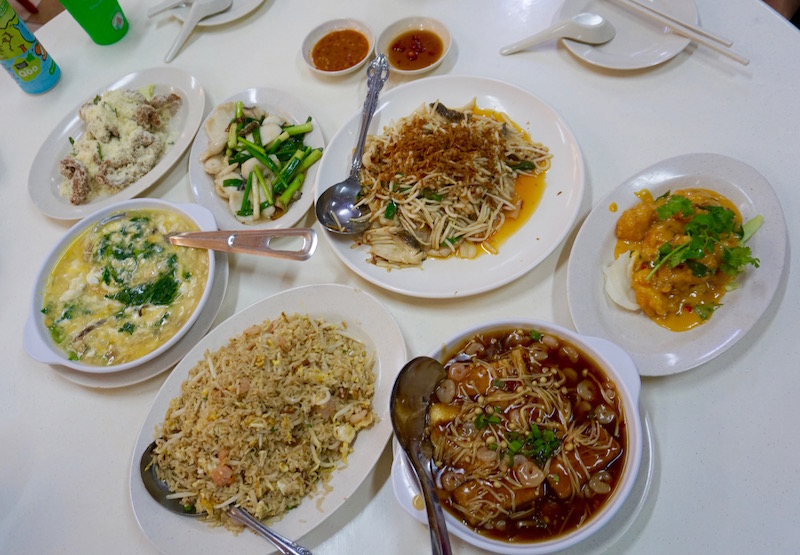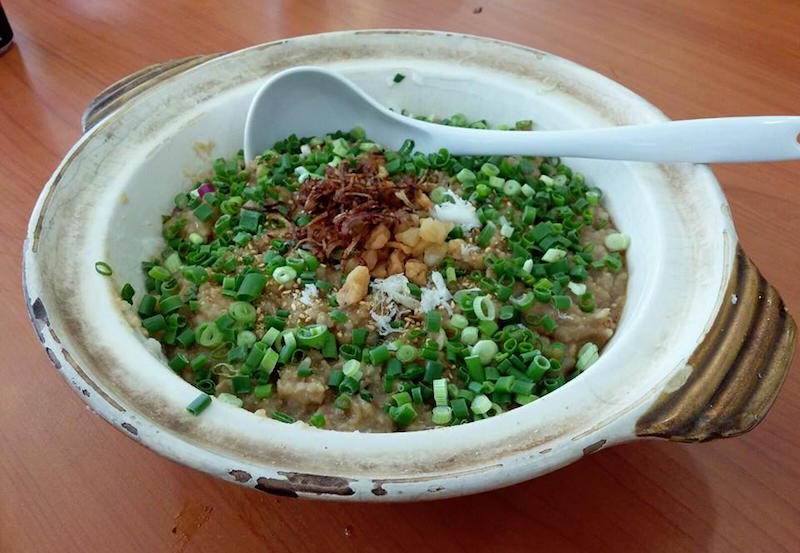An enduring cornerstone of Singapore’s dining scene has been the reliable neighbourhood zi char restaurant. Hokkien for ‘cook and fry’, these wallet-friendly stalls have housed many a family reunion, dishing out comforting home-style food that’s cooked to order in a wok.
However, to compete in the challenging F&B landscape, many of these old-school eateries are evolving to survive. An ever-expanding array of cuisines, the emergence of food delivery companies, and a move towards more nutritious or quirky concepts — all these have called upon the humble zi char to venture into gourmet territory to stay relevant to discerning diners. Besides satiating sophisticated palates by sourcing the freshest and finest ingredients, these establishments have taken one of two epicurean routes to differentiate themselves: innovate or go back to their roots.
While new fusion restaurants are coming in thick and fast, a couple zi char restaurants are bringing something new to the table (pun totally intended). And when it’s done right, it’s oh so good.
New Ubin Seafood is a family-run institution that first saw diners embarking on a gastronomic pilgrimage to Pulau Ubin, then to various ulu locations across the island. Fast track 30 years, and their mission to deliver the freshest seafood and traditional zi char fare, along with their “Singaporean-take on American, French, Italian and Indian cuisine”, has paid off with a recent Bib Gourmand win in Singapore’s first Michelin Guide.

While it may be a surprise to see guests enjoying signatures such as US angus ribeye steak (served with a sinful plate of “heart attack fried rice”), foie gras satay and German-style kurobota pork knuckle, it was a natural decision for restaurant owners Michelle Nicholas and Pang Seng Meng to push the traditional zi char boundaries.
Joline Lim, daughter-in-law and marketing manager for New Ubin Seafood, describes how the fusion menu began with a much-loved family dish. The signature US black angus ribeye is cooked with “just some salt and pepper, as you want the beef taste to stand out. Then, the steak is cut into cubes and served on the chopping board at the dining table, for everyone to dig in with chopsticks.” And the ‘heart attack’ fried rice? Drippings from the beef are used to make an indulgent plate of carbs, because that’s the “Chinese way: why waste it, when you can taste it?”

When other customers saw the beef and rice dish, the requests came flooding in. To meet demand, the owners invested in a charcoal grill — and from there, they began experimenting with other dishes like satay, seafood, lamb chops and smoked pork collar. So from the ashes of the grill, an award-worthy menu was born.
But just throwing ingredients in to sound atas has never been the intention. Lim explains they have to consider whether using an ingredient will make a significant and noticeable difference to the dish, and if the increased price will still be acceptable for diners. “We try to balance bringing in ingredients that will be of value to our customers, and yet not push our price points over the top.”
Having proactive suppliers and partners helps, especially “partners who know that we are open and willing to experiment, so they regularly share new and seasonal ingredients with us.” Lim also attributes customer feedback as inspiration that gets them “to continuously think outside the box and review product offerings.”
Ah Wah, one of the brothers behind Two Chefs Eating Place, says their popular 14-year-old zi char concept also relies heavily on customer input to tailor dishes to individual preferences. “While some people prefer their hor fun with a lot of wok hei, others may complain that it is burnt. If you let us know in advance that you’d prefer a dish to be done a certain way, we’ll do it.”

A new recipe needs to attain an 80% customer approval rating before it appears on the menu. “Building on this constructive feedback is key to our growth as small business owners, and [it’s] one of the many ways that we adapt in a very competitive industry alongside large chain and fast food restaurants.”
While the restaurant’s dishes are inherently done Cantonese-style, they enjoy dabbling with more western influences, like the highly raved about butter pork ribs or honey fried chicken. East or West, consistency is key. “To be successful, it is important to maintain your quality, pricing and standards — this is why we have diners that span young students to the elderly who have been our loyal followers from the beginning.”
Originally making waves in the zi char scene for its selection of Ipoh fried porridge, Royal J’s Seafood has since moved to a new space that brought with it several menu changes. Known for his interest in experimenting with different flavours and textures, owner-chef John Ng decided to focus only on the signature fried porridge and complement it with a variety of zi char dishes, such as the cheese prawns — a hit in Malaysian kopitiams.

On the opposite end of the spectrum are the zi char chefs going to gourmet lengths to preserve the art of local home-style food. These eateries are standing up against the onslaught of pre-mixed and processed, frozen food with wholesome and painstakingly prepared dishes – made just the way our grandmas have always done it.
Dawn Cheng, co-owner of Cheng’s @ 27, seeks to serve freshly procured food similar to how her grandparents ran their restaurant on Pekin Street. “My grandmother cooks the most fabulous food — everything is from scratch. It’s that kind of memory I have. I feel we are the last generation holding onto old beliefs and trying to bestow them on the younger generation.”
She is a battler against “the evolving world of F&B that is all about instant gratification and convenience”, and credits her inspiration to her three-year-old daughter. “I don’t want her to grow up eating processed food and frozen dinners; I want her to understand and appreciate what she is putting into her mouth. I want her to know what is tapioca, and what does it taste like? What is a real chiffon cake supposed to be like?”

The Hainanese-style zi char serves up an intentionally limited menu, with ingredients that are bought from the markets every morning. This passion for cooking with heart is something that Dawn feels is on the decline, and something to which she aims to bring awareness and appreciation to.
The team hand-grate their own tapioca and keep their chiffon cake naturally fragrant with organic coconut oil and gula melaka sugar. They’re currently even attempting to grow the flower that gives kueh salat “that lovely purple-blue colouring, as it’s getting more difficult to procure, and more people now use food colouring instead.”
Also known for their dedication to the craft is Good Chance Popiah, a Singaporean stalwart run by three generations of foodies. Here, you can order DIY popiah, and all the seafood is procured daily to ensure that Ah Boy’s salted egg crayfish and fried mee sua are some of the best in town.

Then there’s Milton Wee, retired banker turned owner of Wee’s Family Coffee Shop, who uses social media to showcase the freshness of his produce, as well as the many satisfied faces of his diners post-feast. He takes pride in the preparation of each dish, staying true to steaming the salted egg yolks to take the ubiquitous salted egg sauce to the next level. To get a little more atas, bring a bottle of wine to accompany your meal — corkage is free.

Whether through modern fusion methods or painstaking, traditional means, these gourmet wok shops add spice and wok hei to the local dining landscape. Their focus on top quality produce and affordable prices ensures they’ll remain contenders against the growing restaurant options for years to come. So here’s to more communal zi char feasts!
New Ubin Seafood: Lam Soon Industrial Building, 63 Hillview Ave. Daily 11am-2pm, 5pm-10pm.
Two Chefs Eating Place: #01-129, 116 Commonwealth Crescent. Daily 11.30am-2.30pm, 5pm-11.30pm. #02-01, 409 Sin Ming Ave. Daily 11am-10.30pm.
Royal J’s Seafood: #01-02, 30 Foch Rd. Mon-Sat 11am-2.30pm, 6pm-11.30pm, Sun 11am-2.30pm, 6pm-11pm.
Cheng’s @ 27: 27 Yong Siak St. Wed-Sun 10.30am-3pm, 5.30pm-9pm, Mon 10.30am-3pm.
Good Chance Popiah: #01-58, 149 Silat Ave. Tues-Sun 11am-2.30pm, 6pm-9.30pm. #01-15 New World Centre, 1 Jalan Berseh. Daily 11am-2.30pm, 6pm-9.30pm.
Wee’s Family Coffee Shop: #01-50, 117 Bedok Reservoir Rd. Daily 8.30am-11.30pm.





Reader Interactions